Carpet Python
Morelia spilota
Carpet pythons are popular pets because of their calm temperament.
Advertisement
Carpet Python Facts
- Prey
- Birds, mammals
- Name Of Young
- Hatchlings, neonates
- Group Behavior
- Solitary except during mating season
- Fun Fact
- Carpet pythons are popular pets because of their calm temperament.
View all of the Carpet Python images!
“A carpet python can grow as long as 12 feet”
Carpet pythons live in Australia and Papua New Guinea. Their varied habitat includes rainforests, savannas, and rocky areas. These snakes have a carnivorous diet and are predators of rodents, lizards, and birds. The lifespan of this snake can exceed 20 years.
4 Carpet Python Amazing Facts
- They are predators of rabbits, mice, birds, and marsupials.
- Carpet pythons got their name because their scale colors look like a woven carpet.
- They climb trees and move around on the ground.
- This snake is sometimes kept as a pet.
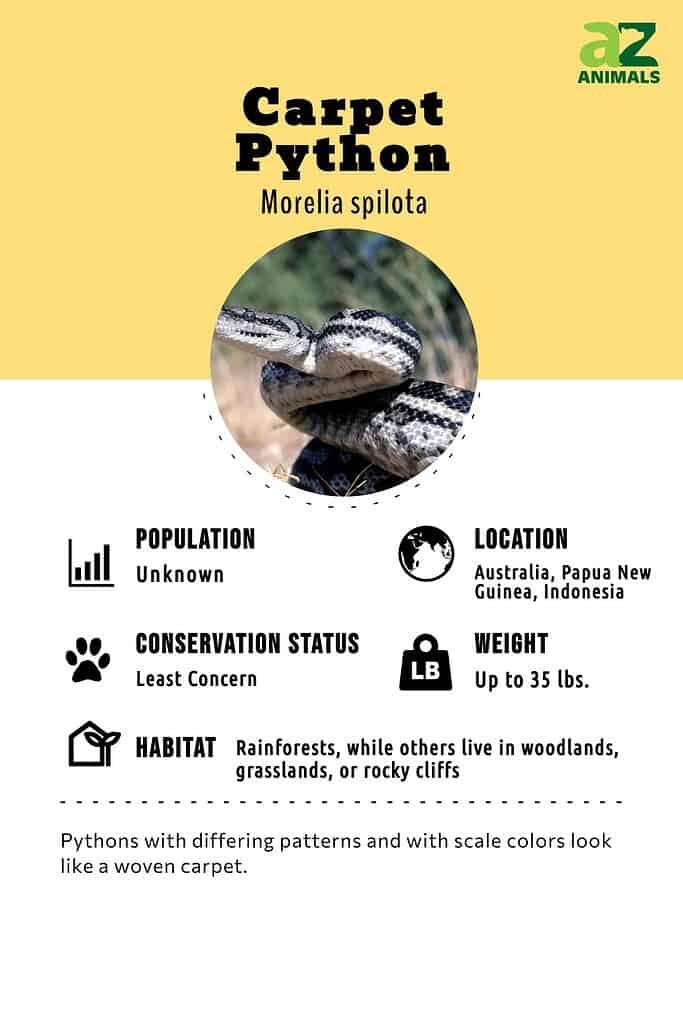
Where to Find Them
Carpet pythons are adaptable and live in different habitats, including rainforests, while others live in woodlands, grasslands, or rocky cliffs. They can live in arid to temperate climates in Australia, New Guinea, the Bismarck Archipelago, and the northern Solomon Islands.
The carpet python is an expert climber, so finding them wrapped around tree branches, fences, and even in houses. They are active snakes that move around within their habitat and also hunt along the forest floor.
These snakes are especially active in the spring and summer. However, they become less active in the cool months of autumn. Some carpet pythons go into brumation if they live in an area with very cold wintertime temperatures.
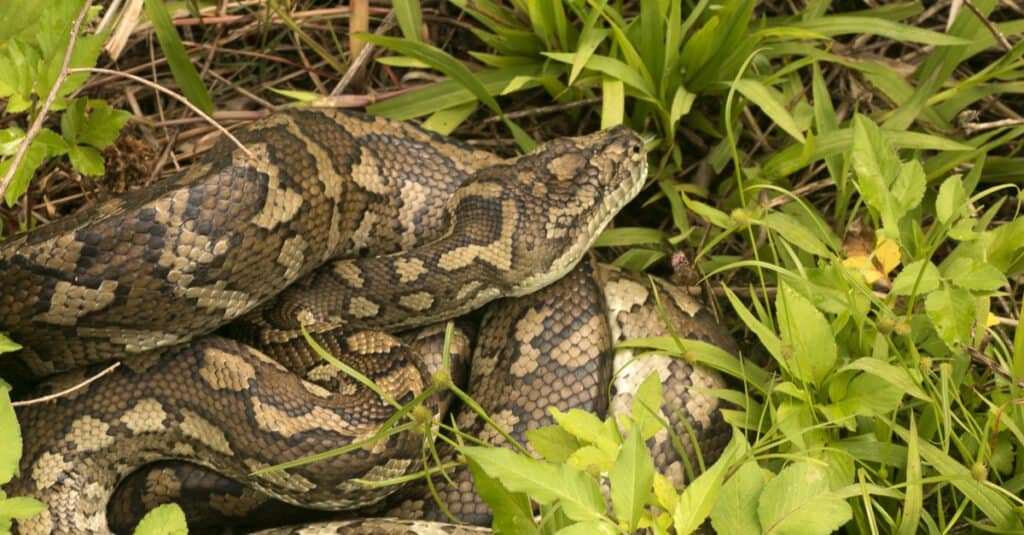
Carpet Pythons are found in Australia and Papua New Guinea.
©Firepac/Shutterstock.com
Types of Carpet Pythons
These four types of carpet pythons belong to the Pythonidae family. Identification of each of these snakes is easier if you focus on their scale colors. Another key to proper identification is location. Carpet pythons live in different areas of Australia and Papua New Guinea.
- Jungle Carpet Python – The Jungle carpet python (Morelia spilota cheynei) is likely the most recognizable due to its black bands of scales atop a bright yellow background. It grows to be about eight feet and lives in a rainforest habitat in the northeastern part of Queensland.
- Southern Carpet Python (Morelia spilota imbricata) – The Southern Carpet Python lives in the southern portion of western Australia and eastern part of South Australia. It grows to be seven and a half feet long as an adult. Its scale colors are dark brown or olive with black splotches.
- Diamond Python – The Diamond python (Morelia spilota spilota) is found in the eastern part of New South Wales and in New Guinea. It is covered in black scales featuring a yellow or white pattern of small diamond shapes. They are an average of seven feet long and have a docile temperament. This snake is a popular pet.
- Darwin Carpet Python – The Darwin Carpet Python (Morelia spilota variegata) is found in a location in the northern section of western Australia. Its average size is just under six feet long. The colors of the Darwin carpet python are a mixture of dark and light brown. This type of python is another popular pet snake.
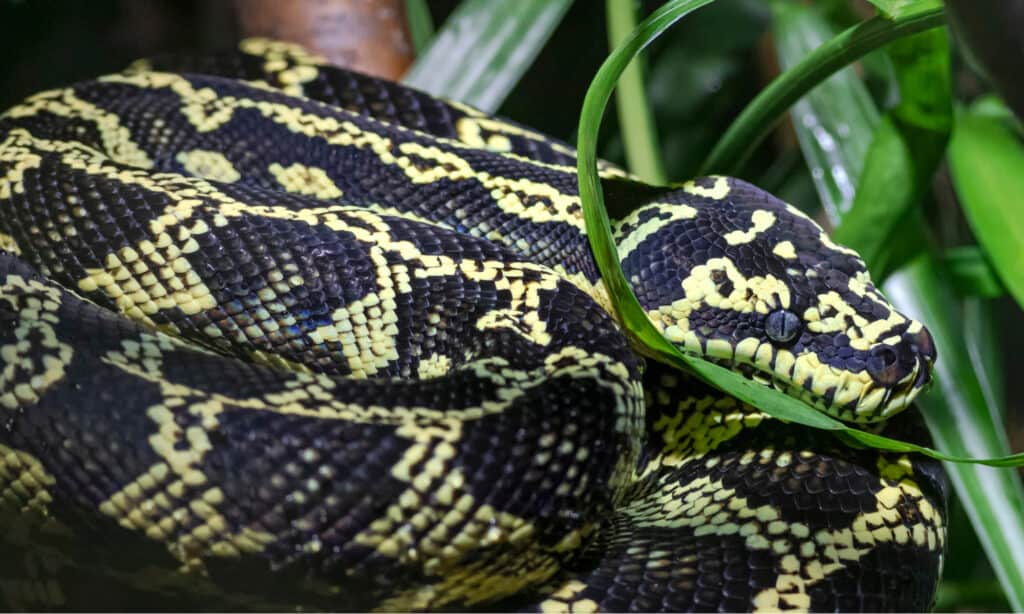
Diamond pythons have striking black and yellow bands or stripes.
©Henner Damke/Shutterstock.com
Scientific Name
Morelia spilota is the scientific name of the carpet python. The word Morelia is its genus and the word spilota is Greek meaning spotted. This refers to the colors and patterns of this snake. It’s in the Pythonidae family and the class Reptilia.
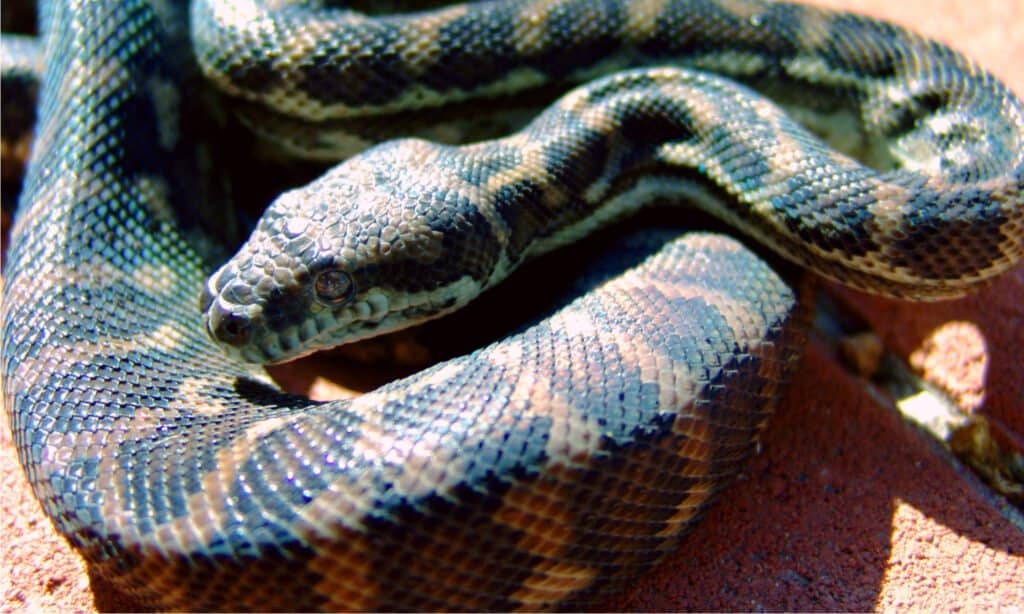
Coastal carpet pythons’ patterns and colors can vary dramatically from one individual to the next.
©sharyn/Shutterstock.com
History and Evolution
While it may come as a surprise, the ancestors of pythons and other snakes actually had legs and were similar to lizards and other aquatic reptiles. At some point, it must have become advantageous to sleek on the ground and their legs became more and more unused and eventually useless, vestigial, or just gone.
Previously classified with boas, modern research shows that the pythons and boas are separate species. They are examples of convergent evolution in different parts of the world, much like monkeys evolved differently in Africa and South America while having shared ancestors. One major difference is that boas give birth to live young, while pythons lay eggs. Pythons also have their heat-sensing pits on their labial scales, and boas have them in between their labial scales.
Because pythons are such great swimmers and have been known to venture into the ocean, it is assumed that early ancestors ventured into far waters and found new homes. Here, the different types of pythons evolved on a different path than their sister pythons on other landmasses.
Population & Conservation Status
The carpet python’s population is unknown. According to the IUCN Red List, this species is reported as Least Concern. Habitat loss is thought to be the reason behind its decreasing population.
How to Identify Them: Appearance and Description
The most well-known type of this snake species is the jungle carpet python. Identification of a jungle carpet python is relatively easy due to its series of black splotches over a bright yellow background of scales. Though the average length of this snake is eight feet, it can be up to 12 feet long in size! Furthermore, they can be as heavy as 33 pounds.
How to identify a jungle carpet python:
- Black bands of scales on a bright yellow background similar to a decorative woven rug.
- A pit on each side of its head to help them detect the presence of warm-blooded prey.
- A cream or white underbelly.
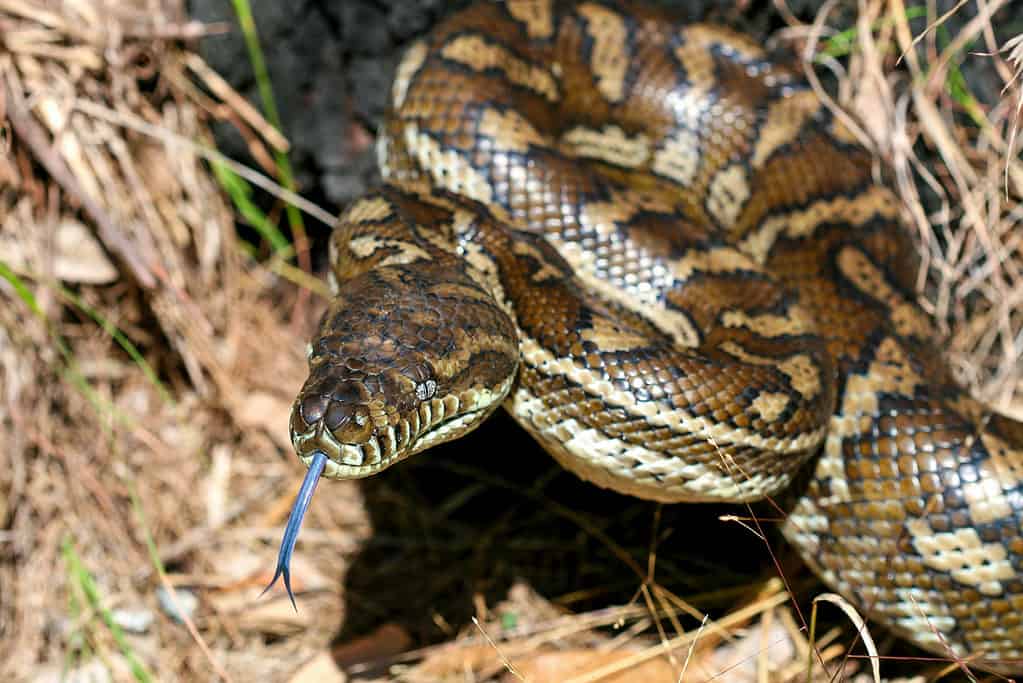
The different types of carpet pythons have different looks and patterns.
©Michelle Marks/Shutterstock.com
How Dangerous Are They?
Carpet pythons are known to be mild-mannered snakes. This is a big part of the reason why they are popular pets.
One of the facts to keep in mind about this snake is it’s not venomous. They hunt their prey by using the pits on their head as a guide. These pits sense warm-blooded prey in their habitat. Once the snake catches up to its prey, it wraps around it to suffocate it.
But, just because these snakes have a mild-mannered temperament doesn’t mean they won’t bite. The snake is most likely to bite if it’s startled or feels threatened. So, you can pay a painful price if you sneak up on it! It has sharp teeth that curve backward to keep prey in place as it swallows.
If you’re bitten by a carpet python, the first thing to do is clean the bite area with hot water and soap. Next, dry your skin, then bandage the wound. If the pain doesn’t subside, see a medical professional.
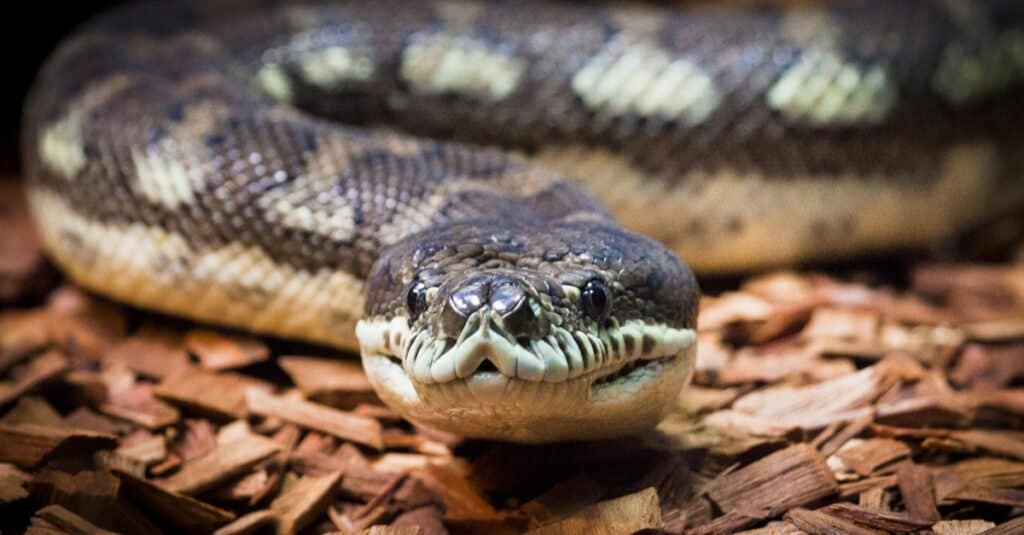
Carpet pythons are known to be mild-mannered snakes.
©Jason Benz Bennee/Shutterstock.com
Behavior and Humans
Carpet pythons are docile snakes with a shy temperament. They are a popular pet among snake enthusiasts and are available at a reasonable price. They aren’t venomous or prone to bite unless threatened.
These snakes sometimes find their way into homes in the suburbs. They may be searching for rodents or a cool place to relax. Though this happens sometimes, these snakes are not considered pests.
Similar Animals
View all 235 animals that start with CCarpet Python FAQs (Frequently Asked Questions)
Are carpet pythons venomous?
No, this reptile is not venomous.
How do carpet pythons hunt?
These snakes have a pit on each side of their head that detects the presence of warm-blooded animals. They are predators of rabbits, mice, birds, and marsupials so their pits help them to track down these animals. The snake wraps around its prey and suffocates it.
Are carpet pythons aggressive?
No, these snakes have a gentle temperament.
Where do carpet pythons live?
They live in Australia and Papua New Guinea. Some live in a location with rainforests while others live in grasslands, rocky areas, and semi-arid landscapes.
What do carpet pythons eat?
They eat a diet of rats, mice, rabbits, birds, and marsupials.
Does a carpet python bite hurt?
Yes! Though it doesn’t inject venom, its teeth are sharp and can deliver a painful bite.
How big does a carpet python get?
The different types of carpet pythons vary in size. For instance, a jungle carpet python can grow to 12 feet while a diamond python reaches a length of seven feet.
Python
Its name comes from its mix of scale colors. They’ve been compared to the woven fabric of a decorative carpet.
Is a carpet python a good pet?
Many snake enthusiasts will answer yes. These snakes are docile and display beautiful colors and patterns. Plus, they are available from most snake breeders for a reasonable price. These reptiles have a long lifespan of up to 20 years and sometimes live years longer with proper care.
Some snake owners look for carpet python morphs to keep as pets. Morphs are carpet pythons with mutations in their color or pattern. A Darwin albino carpet python is just one of many examples of morphs. It has a white background of scales with a pattern of yellow or orange markings.
Is a carpet python a good beginner snake?
No. This snake is more appropriate for a person who has taken care of snakes in the past.
Though carpet python snakes are docile, they can sometimes do unpredictable things. Someone who has experience with a pet snake is likely to see the signs of a distressed snake. Consequently, the person knows to leave it alone. Alternatively, a snake owner who’s a beginner may not be able to see those signs and gets bitten as a result.
Do carpet pythons need UV light?
A UV light is not necessary for a carpet python’s care because it’s a nocturnal reptile. However, a reliable thermostat is a must-have to ensure the proper temperature in a reptile’s enclosure.
Thank you for reading! Have some feedback for us? Contact the AZ Animals editorial team.


















